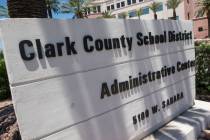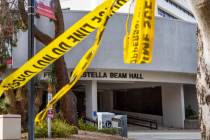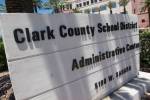No Child Left Behind law needs improvement, not schools, critics contend
The halls of Snyder Elementary School are hushed and hot. To save money, air conditioning is limited during summer vacation.
But the halls aren't entirely empty. Principal Traci Davis and several workers are sweating away to ready classrooms for the new school year.
However, Davis has more to contend with than just returning students. Yet again, Snyder fell short of meeting No Child Left Behind requirements. Yet again, the school, located east of Lamb Boulevard and south of Charleston Boulevard, is on the dreaded "needs improvement" list despite making impressive gains.
About 80 percent of its students tested as proficient in math, exceeding the 65.9 percent requirement of the federal education reform. About 62 percent of students proved proficient in reading and writing -- a notable achievement considering that three-fourths of students at Snyder speak English as a second language.
District parents need to know that, Davis said. No Child Left Behind doesn't show the entire picture behind test results. Parents and the public just see a frowny face sticker slapped beside the school's name. In reality, just one niche group of Snyder's 900 students didn't meet the test requirements -- special education students.
"We failed just because three students didn't make it," said Davis, who blames not the students but the system that fails an entire school if just one of 41 student subgroups falls short.
"If I come to school knowing students have grown, I take No Child Left Behind with a grain of salt," she said Thursday.
She's not the only one.
Nevada and many other states are planning to seek waivers from the federally required program for this exact reason, said Keith Rheault, Nevada superintendent of public schools.
That was evident in a recent conference call of state and U.S. Department of Education officials, he said. An increasing number of states don't want to use No Child Left Behind.
That has become the case because No Child Left Behind is a pass/fail measure that doesn't acknowledge student growth. Only one question is asked: Are students performing at grade level based on one test a year?
The federal law calls for all students to test as proficient by 2013-14. Common sense dictates that most schools won't even reach 90 percent, which will be the bar high schools have to meet this coming school year under No Child Left Behind, Rheault said.
"Only three or four schools in the state would reach that," he said.
The decreasing number of schools in compliance with No Child Left Behind is already evident in Clark County, the state's largest district. District officials reported Wednesday that only one-third of the county's public schools met federal requirements in 2009-10.
That trend probably will be reflected across the state, Rheault said, adding that results for most districts haven't been released because appeals about their scores are pending.
For that reason, the state is proposing to replace No Child Left Behind with a "growth model," something many states are leaning toward, Rheault said.
The growth model would measure student progress over time instead of relying on an annual test at certain grades to assess student proficiency in a given subject at just one point in time, which is what No Child Left Behind does. The Nevada Department of Education will reveal the growth model on Aug. 15, Rheault said.
But states need approval from the U.S. Department of Education to replace No Child Left Behind and implement a new academic measuring system.
Kentucky probably will be the first to seek the waiver, Rheault said. Nevada will wait for a couple of states to apply before doing so itself. That way, the state can see what restrictions are put in place by replacing the federal program.
"I haven't heard from any superintendents who aren't behind the growth model," said Rheault, who had his monthly conference call with all Nevada superintendents Thursday. "Pretty much 100 percent back it."
Flaws in No Child Left Behind have been apparent from its beginning in 2002-03, he said.
Take the case at Palo Verde High School in Summerlin.
The school's academic performance has consistently ranked near the top of the district, which is the nation's fifth-largest public school system with 363 schools. But Palo Verde has never shown adequate yearly progress under No Child Left Behind.
"I really don't put a lot of weight on our designation -- adequate or needs improvement," Principal Dan Phillips said.
About 85 percent of Palo Verde's students score as proficient in math, and 90 percent in writing and reading, he said. Graduating students received $12 million in scholarships last year and $16 million the previous year.
But the school always fails No Child Left Behind because one of its subgroups -- special education, limited-English speakers or a different category -- doesn't make the cut.
After receiving the latest round of standings, the school focuses on improving student performance in the low-scoring group, Phillips said, but then a different group falls short the following year.
"As soon as you plug one hole, another one opens," he said. "You're always shooting at a moving target."
As a result, the entire school is stigmatized as failing.
Many parents don't even heed the results of No Child Left Behind. The program allows parents to move their children to a different school if their neighborhood school consistently fails the yearly assessment.
"Parents very, very rarely switch their children's schools," said David Roddy, spokesman for Clark County School District.
Only one of Snyder's 900 students left when given the chance, Principal Davis said.
"I explain it to parents," she said. "I show the test scores."
Contact reporter Trevon Milliard at tmilliard@reviewjournal.com or 702-383-0279.























